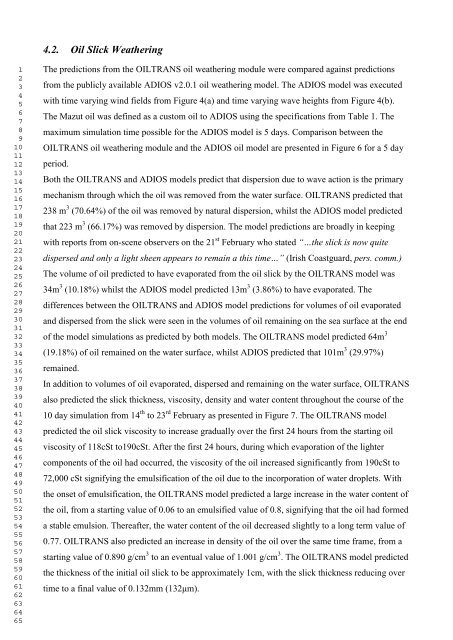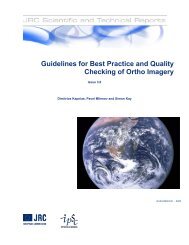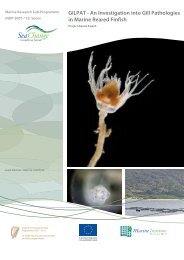The oil spill model OILTRANS and its application to the Celtic Sea ...
The oil spill model OILTRANS and its application to the Celtic Sea ...
The oil spill model OILTRANS and its application to the Celtic Sea ...
You also want an ePaper? Increase the reach of your titles
YUMPU automatically turns print PDFs into web optimized ePapers that Google loves.
4.2. Oil Slick Wea<strong>the</strong>ring1234567891011121314151617181920212223242526272829303132333435363738394041424344454647484950515253545556575859606162636465<strong>The</strong> predictions from <strong>the</strong> <strong>OILTRANS</strong> <strong>oil</strong> wea<strong>the</strong>ring module were compared against predictionsfrom <strong>the</strong> publicly available ADIOS v2.0.1 <strong>oil</strong> wea<strong>the</strong>ring <strong>model</strong>. <strong>The</strong> ADIOS <strong>model</strong> was executedwith time varying wind fields from Figure 4(a) <strong>and</strong> time varying wave heights from Figure 4(b).<strong>The</strong> Mazut <strong>oil</strong> was defined as a cus<strong>to</strong>m <strong>oil</strong> <strong>to</strong> ADIOS using <strong>the</strong> specifications from Table 1. <strong>The</strong>maximum simulation time possible for <strong>the</strong> ADIOS <strong>model</strong> is 5 days. Comparison between <strong>the</strong><strong>OILTRANS</strong> <strong>oil</strong> wea<strong>the</strong>ring module <strong>and</strong> <strong>the</strong> ADIOS <strong>oil</strong> <strong>model</strong> are presented in Figure 6 for a 5 dayperiod.Both <strong>the</strong> <strong>OILTRANS</strong> <strong>and</strong> ADIOS <strong>model</strong>s predict that dispersion due <strong>to</strong> wave action is <strong>the</strong> primarymechanism through which <strong>the</strong> <strong>oil</strong> was removed from <strong>the</strong> water surface. <strong>OILTRANS</strong> predicted that238 m 3 (70.64%) of <strong>the</strong> <strong>oil</strong> was removed by natural dispersion, whilst <strong>the</strong> ADIOS <strong>model</strong> predictedthat 223 m 3 (66.17%) was removed by dispersion. <strong>The</strong> <strong>model</strong> predictions are broadly in keepingwith reports from on-scene observers on <strong>the</strong> 21 st February who stated “…<strong>the</strong> slick is now quitedispersed <strong>and</strong> only a light sheen appears <strong>to</strong> remain a this time…” (Irish Coastguard, pers. comm.)<strong>The</strong> volume of <strong>oil</strong> predicted <strong>to</strong> have evaporated from <strong>the</strong> <strong>oil</strong> slick by <strong>the</strong> <strong>OILTRANS</strong> <strong>model</strong> was34m 3 (10.18%) whilst <strong>the</strong> ADIOS <strong>model</strong> predicted 13m 3 (3.86%) <strong>to</strong> have evaporated. <strong>The</strong>differences between <strong>the</strong> <strong>OILTRANS</strong> <strong>and</strong> ADIOS <strong>model</strong> predictions for volumes of <strong>oil</strong> evaporated<strong>and</strong> dispersed from <strong>the</strong> slick were seen in <strong>the</strong> volumes of <strong>oil</strong> remaining on <strong>the</strong> sea surface at <strong>the</strong> endof <strong>the</strong> <strong>model</strong> simulations as predicted by both <strong>model</strong>s. <strong>The</strong> <strong>OILTRANS</strong> <strong>model</strong> predicted 64m 3(19.18%) of <strong>oil</strong> remained on <strong>the</strong> water surface, whilst ADIOS predicted that 101m 3 (29.97%)remained.In addition <strong>to</strong> volumes of <strong>oil</strong> evaporated, dispersed <strong>and</strong> remaining on <strong>the</strong> water surface, <strong>OILTRANS</strong>also predicted <strong>the</strong> slick thickness, viscosity, density <strong>and</strong> water content throughout <strong>the</strong> course of <strong>the</strong>10 day simulation from 14 th <strong>to</strong> 23 rd February as presented in Figure 7. <strong>The</strong> <strong>OILTRANS</strong> <strong>model</strong>predicted <strong>the</strong> <strong>oil</strong> slick viscosity <strong>to</strong> increase gradually over <strong>the</strong> first 24 hours from <strong>the</strong> starting <strong>oil</strong>viscosity of 118cSt <strong>to</strong>190cSt. After <strong>the</strong> first 24 hours, during which evaporation of <strong>the</strong> lightercomponents of <strong>the</strong> <strong>oil</strong> had occurred, <strong>the</strong> viscosity of <strong>the</strong> <strong>oil</strong> increased significantly from 190cSt <strong>to</strong>72,000 cSt signifying <strong>the</strong> emulsification of <strong>the</strong> <strong>oil</strong> due <strong>to</strong> <strong>the</strong> incorporation of water droplets. With<strong>the</strong> onset of emulsification, <strong>the</strong> <strong>OILTRANS</strong> <strong>model</strong> predicted a large increase in <strong>the</strong> water content of<strong>the</strong> <strong>oil</strong>, from a starting value of 0.06 <strong>to</strong> an emulsified value of 0.8, signifying that <strong>the</strong> <strong>oil</strong> had formeda stable emulsion. <strong>The</strong>reafter, <strong>the</strong> water content of <strong>the</strong> <strong>oil</strong> decreased slightly <strong>to</strong> a long term value of0.77. <strong>OILTRANS</strong> also predicted an increase in density of <strong>the</strong> <strong>oil</strong> over <strong>the</strong> same time frame, from astarting value of 0.890 g/cm 3 <strong>to</strong> an eventual value of 1.001 g/cm 3 . <strong>The</strong> <strong>OILTRANS</strong> <strong>model</strong> predicted<strong>the</strong> thickness of <strong>the</strong> initial <strong>oil</strong> slick <strong>to</strong> be approximately 1cm, with <strong>the</strong> slick thickness reducing overtime <strong>to</strong> a final value of 0.132mm (132μm).
















